Back when humanity was still stacking up rocks to make festival stages, bass players were confined to an amp, a cable and an instrument, while guitar players got all the cool toys. It took several decades before bass players began to put together pedalboards of their own, seeking equity with the stage real estate guitarists had claimed. In this article, we're going to balance the equation and look at the best effects pedals for bass, from EQ and compression to distortion, filters, modulation pedals and more. We'll be covering a little history first, but if you just want to get to the gear, feel free to use the links below in the handy Table of Contents to jump right there.

Pictured: BOSS GT-1B Bass Multi-Effects Pedal
Table of Contents
History of Bass Pedals
Our Choices by Effect Type
Best Preamp and DI Bass Pedals
Best Distortion Bass Pedals
Best Compressor Bass Pedals
Best Filter and EQ Bass Pedals
Best Modulation Bass Pedals
Best Multi-Effects Bass Pedals
Best Synth Bass Pedals
Wrapping It All Up
History of Bass Pedals
It's interesting that the first use of a fuzz tone on record wasn't rock and wasn't a guitar. It was on country singer Marty Robbins' 1961 hit, "Don't Worry." The 19 seconds of fuzz bass solo in the middle of what was otherwise a mostly acoustic song was the result of a malfunction in a channel of the mixing board. After the producer and engineer decided to keep "that weird sound," engineer Glenn T. Snoddy figured out exactly what had happened, and recreated the "faulty" circuit, just in case anybody wanted it again. This circuit ended up in a box with a footswitch as the Maestro FZ-1 Fuzz-Tone, and the modern age of stompboxes was off to the races.
For the first several years, it was primarily guitarists using these new boxes. But an increasing number of bass players were dipping their toes into the pool—for example, Bill Wyman's use of fuzz bass on The Rolling Stones' 1966 recording of "Under My Thumb." The first big breakthrough for bass effects pedal use, though, occurred when Sly Stone hired bassist Larry Graham away from Graham’s mother's gospel trio for his new band. In addition to his slap and pop bass style, Graham, a one-time guitarist, was a pioneer in the use of effects pedals for bass. He famously used the built-in fuzz of his Acoustic 360 bass amp on Sly and the Family Stone's well-documented set at the 1969 Woodstock Music Festival. But Graham, throughout his career, has also used fuzz pedals, wah pedals and phase shifters. He was also one of the first to use an envelope filter on the bass.

Pictured: MXR M82 Bass Envelope Filter
Many of the bassists who incorporated Graham's "thumping and plucking" playing style, like Bootsy Collins, Stanley Clarke and others, also adopted his use of pedals, with some, like Collins, adding delay and other effects to expand their palette of sonic tricks. But there was one big problem holding bass players back from a more widespread adoption of effects pedals. Battery-powered effects designed for guitar simply couldn't deal gracefully with bass. Inherent frequency response limitations in the designs meant a loss of bass frequencies, turning many pedals that sounded great for guitars into serious tone sucks for bass. So, bassists had to wait.
In the late 1980s, Roland/BOSS began designing pedals that were intended specifically for bass guitar. One key to the success of these pedals was the use of low-pass and high-pass filters to leave the fundamentals of bass notes untouched while processing overtones so that the impact of the bass didn't get lost. This period also saw the first rackmount multi-effects units designed specifically for bass. As the '90s began, many more companies, seeing the popularity of the BOSS bass effects, began to develop pedals specifically to enhance and expand the sonic possibilities bassists had.

Pictured: Electro-Harmonix Bass Big Muff Pi Bass Effects Pedal
The increasing presence and popularity of DSP-based physical modeling in the mid-'90s began to be felt in the bass world as well as the guitar world. Analog and digital products inspired each other to up their respective games as well. From the analog Tech 21 SansAmp Bass Driver to the Line 6 Bass POD, bass-specific products, many of which combined preamps with effects, started hitting the stores, offering bassists far more options and beginning to change the sound and role of the bass in popular music. Thirty years later, the variety and quality of bass-specific effects continues to expand and grow.
Our Choices By Effect Type
We've broken down our choices into six basic categories to help you zero in more quickly on the best bass effect pedals for your needs. First, we'll break down what those categories are, then walk you through our selections for each category.
Types of Bass Effects
Unlike earlier decades, there are many dedicated bass effects pedals available today, but they tend to break down into a handful of basic categories.

Pictured: Darkglass Alpha Omega Bass Effects Pedal
Preamps and DIs:
While the DI (Direct Injection) box has been one of the most prominent ways of recording bass and getting a solid bass signal into a live mixing board, having a DI combined with a preamp specifically designed for bass makes it a far more powerful tool. The development of pedals that combine the two is especially handy for the growing use of "silent stage" setups for houses of worship, clubs, shows at venues like casinos, and touring bands who like to keep stage gear to a minimum. They range from basic EQ and gain controls to more comprehensive units that include switchable channels, built-in distortion/overdrive and more.
Boost and Distortion:
Whether you're looking for just a quick boost from hot to hotter or want a full-blown fuzz, this is the place to get that extra edge on your sound. These can be very basic volume boosts or pedals with split outputs and multiple voicing.
Compressor:
Probably the most widely used effect for bass, a good compressor helps smooth out your signal and keep your sound in the right spot in the mix. It's essential for the pop and snap of modern funk playing and for keeping dynamics even and controlled.
Filter and EQ:
We're grouping these effects together because they're related in concept and in use. Envelope filters (aka auto-wah) and wah pedals were among the earliest effects used on bass guitar, second only to distortion. The use of a supplementary equalizer pedal (EQ) enables bassists to further expand their tonal palette beyond the basic tone they have dialed in on their amplifier or preamp.
Modulation:
Whether time-based (chorus) or frequency-based (phase shifter), modulation effects add that rich, harmonic "swoosh" to your sound. Important for bass versions of this effect is to have some sort of filter that leaves the fundamental untouched.
Multi-Effects:
All of the above, plus more.
Best Preamp and DI Bass Pedals
Whatever else you're doing, you'll need a preamp to shape your sound on the way to your amp, and a DI to get it into a mixer or interface. We've got some great choices here.
|
Pedals |
Tonal Characteristics |
Power Supply and Draw |
Direct Out |
|
Classic Ampeg amp and cab tone |
9V, 200mA |
Yes |
|
|
Clean tube to British crunch |
12V, 600mA |
No |
|
|
Warm and rich |
18V, 36mA |
Yes |
|
|
Punchy and tight to brutal and raw |
9V, 30mA |
Yes |
Ampeg SGT-DI Blue Line Anniversary Edition
Why It's Cool: A perennial best-seller, the Ampeg SGT-DI lets you channel the soul of vintage Ampeg amps—SVT grit, B15 warmth and everything in between—all in a portable pedal format.
Things to Consider:
- Switchable SVT and B15 voicings give you iconic Ampeg tones
- Amp-like response via built-in compression and grit control
- XLR DI out with cab sim for studio or stage-ready tone shaping
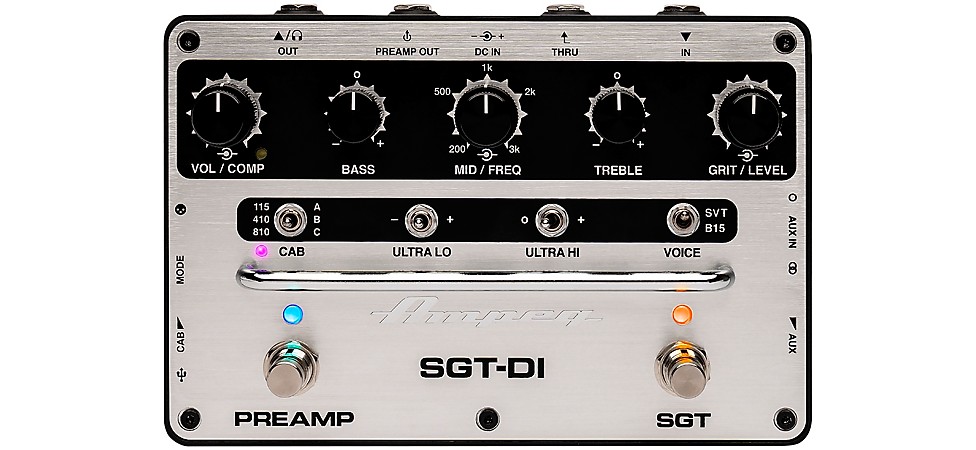
Shop Now: Ampeg SGT-DI All-in-One Bass Box Effects Pedal
Ampeg's SGT-DI is a certified chameleon of a pedal, combining the legendary tones of the iconic SVT and B15 amps with almost too-good-to-be-true convenience. This pedal provides a powerful combination of EQ options, onboard speaker cab emulations and studio-grade DI capability.
Two notes Audio Engineering ReVolt
Why It’s Cool: This all-analog amp simulator is an adaptable option for players of any style or genre.
Things to Consider:
- Three versatile tones to choose from
- Dry/wet blend lets you dial in your desired drive settings
- FX Loop and MIDI I/O make this a flexible centerpiece for your pedalboard

Shop Now: Two notes Audio Engineering ReVolt 3-Channel Preamp
The ReVolt from Two notes Audio Engeneeing is a forward-thinking, 3-channel preamp purpose-built to serve as the beating heart of your rig. This critically acclaimed preamp solution has been engineered with a singular mission: to empower players with an array of foundational tones. Forget any preconceptions you have about a typical amp-in-a-box, preamp or DI—ReVolt Bass stands apart. It’s inspired by a trio of iconic tones, fueled by 200V of power and a genuine all-analog signal path. Versatile enough to take on a myriad of usage scenarios, it delivers the edge you need thanks to its integrated dry/wet drive channel blend. This rock-solid option will make your bass the bedrock of any performance.
Aguilar Tone Hammer V2
Why It’s Cool: This powerful, contemporary tonal masterpiece is ready for any gig, no matter how you use it.
Things to Consider:
- Ideal for gigging and touring
- Enhanced drive circuit and expanded gain range
- Round, full tones inspired by Aguilar’s best-selling tube amps

Shop Now: Aguilar Tone Hammer V2 Preamp Bass Effects Pedal
Taking a tonal nod of the head from its sibling, the Tone Hammer 700 V2 amp head, the Aguilar Tone Hammer V2 preamp bass effects pedal delivers an updated drive circuit, direct recording and monitoring capabilities, as well as the added bonus of being able to drive a power amp, allowing you to use it as a standalone preamp. With sounds reminiscent of Aguilar’s legendary amps, this sturdy pedal delivers iconic tube amp tones that the brand is known for. Included, you’ll find a 3-band EQ with a sweepable midrange so you can hone in on the perfect frequency, as well as a drive control that adds an impressive amount of grit and punch when you want more aggression. These tone-shaping features combine to provide you with a wide range of sonic possibilities, from vintage warmth to modern grind. Whether you’re cranking things up on stage or utilizing the headphone jack for silent jam sessions, the Tone Hammer V2 is a force to be reckoned with.
Darkglass Alpha Omega
Why It’s Cool: This rugged and feature-packed pedal sports a built-in optical compressor that enhances sustain and provides smooth, musical compression.
Things to Consider:
- Onboard optical compressor for transparent, dynamic control
- Versatile enough for studio and live applications
- 3-band EQ with sweepable midrange

Shop Now: Darkglass Alpha Omega Bass Effects Pedal
The Darkglass Alpha Omega is an extremely flexible option that houses EQ, compression, drive and blend settings in a road-tested enclosure. If you’re looking for an adaptable preamp that provides a bevy of onboard effects, this pedal delivers in spades. Striking a nice balance between its array of different settings, the blend knob allows you to mix your distorted and clean signals to create the perfect ratio of drive and clarity. Whether you play modern metal, classic rock or jazz fusion, the Alpha × Omega has the tools for you to craft your own unique, one-of-a-kind sound.
Best Distortion Bass Pedals
Need just a little extra level to pop your bass out or drive your amp a little more? Looking for roaring fuzz bass? This section is where to find your answer.
|
Pedals |
Tonal Characteristics |
Power Supply and Draw |
Included Effects |
|
Thick, harmonically rich fuzz designed to replicated LCD Soundsystem's bass tones |
9V DC, 25mA |
Fuzz with blendable low-end retention |
|
|
Fat and sludgy to clear and present |
9V, 7mA |
Fuzz |
EarthQuaker Devices Chelsea Low-End Fuzz Driver
Why It's Cool: EarthQuaker Devices and LCD Soundsystem’s James Murphy teamed up to bottle the massive, gritty bass fuzz that’s powered the band’s albums—and now, your pedalboard.
Things to Consider:
- Handmade in Akron, Ohio, with boutique-level attention to detail
- Thick, harmonically rich fuzz designed for bass, retaining low-end clarity
- Blends seamlessly with clean signal for a mix-ready bass tone

Shop Now: EarthQuaker Devices Chelsea Low-End Fuzz Driver
If you’ve ever cranked an LCD Soundsystem record and thought, “That bass tone!”—this is it. The EarthQuaker Devices Chelsea Low-End Fuzz Driver takes the pulsing, sawtoothed fuzz that defined their sound and delivers it in a handmade, boutique-quality stompbox. Designed specifically for bass, it balances searing distortion with just the right amount of low-end retention, so your tone stays massive, not muddy. From laying down a dancefloor-shaking groove to blasting a blown-out, industrial bassline, the Chelsea is built to rumble.
Electro-Harmonix Bass Big Muff Pi
Why It’s Cool: What could be the most popular fuzz effect of all time, the Big Muff Pi is now tailor-made for bass.
Things to Consider:
- Classic Big Muff Pi fuzz tones
- Dual outputs give you recording/performing flexibility
- Bass boost EQ reintroduces low frequencies when tone settings are high
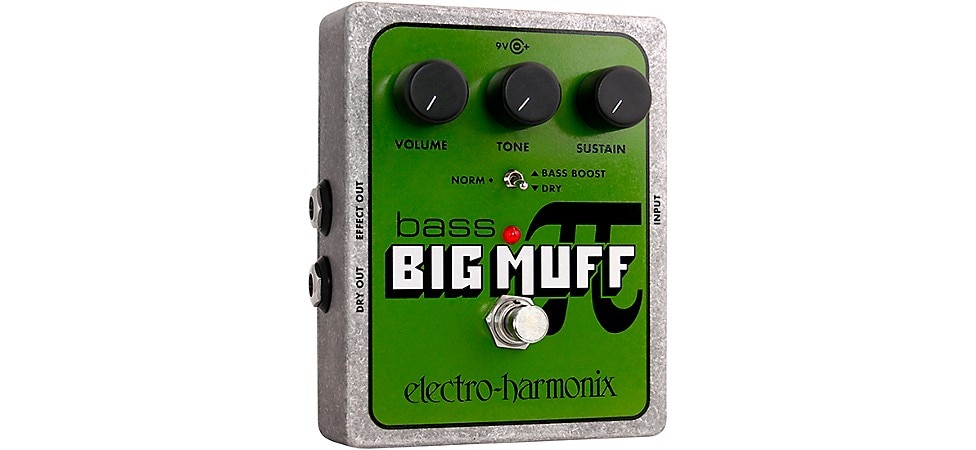
Shop Now: Electro-Harmonix Bass Big Muff Pi Bass Effects Pedal
The Electro-Harmonix Big Muff Pi is one of the most widely used fuzz pedals in the history of amplified music, and the Bass Big Muff Pi takes all that insanity and voices it specifically for bass. One very important feature here is the split Dry and Effect outputs, which enable you to record the clean and fuzz outputs separately, run to two separate amps, two channels of the same amp or to separate mixer inputs live. Best of all, because nothing exceeds like excess, there's a switchable bass boost to send the fuzz totally over the top. For sheer, unadulterated fun, fuzz bass has got to be right up near the top of the list.
Best Compressor Bass Pedal
Every bassist needs a good compressor somewhere in their signal chain. No matter what style or genre you play, that's just a fact.
|
Pedal |
Tonal Characteristics |
Power Draw |
Attack and Release |
|
Organic to harmonically rich and colorful |
9V, 100mA |
Variable |
Empress Effects Bass Compressor
Why It’s Cool: This pedal features everything players love about the original Empress Effects Compressor pedal, with bass-centric features in a pedalboard-friendly size.
Things to Consider:
- Onboard metering of both the input signal, and gain reduction
- Small footprint and top-mounted jacks
- Sidechain functionality gives you a wider range of compression possibilities

Shop Now: Empress Effects Bass Compressor Effects Pedal
An extremely versatile effects pedal, the Empress Effects Bass Compressor packs loads of functionality into a footprint that will make any pedalboard enthusiast happy. From its variable attack and release settings to a switchable ratio that ranges between 2:1 and 10:1, this pedal offers complete control of your dynamic range. The standout feature of the Bass Compressor is the three-way switch that controls the Tone and Colour setting. Giving you the ability to dial in transparent, mid-scoop and mid-bump settings, this functionality takes your compression from clean to colored on demand. A nice addition is the built-in side chain HPF so you can retain your powerful low end while smoothly controlling your mids to avoid nasty, distracting bite. Plus, with additional external sidechain I/O, the possibilities on stage or in the studio are seemingly endless.
Best Filter and EQ Bass Pedals
EQ and its ability to fine-tune an instrument's tone has been central to recording and performance since it was first invented, but putting it in a stompbox and making it usable as an effect opened up new frontiers. The vocal-like sound of wah pedals and envelope filters have been second only to distortion as an effect for bass players since those effects first arrived on the scene. The sub-octave, also known as octave-down effect, has enabled bassists to thicken and reinforce their dominance of the deep.
|
Pedal |
Tonal Characteristics |
Power Draw |
Onboard Expression Pedal |
|
Pitch shifting, octave effects |
265mA |
Yes |
|
|
Muted and wonky to wide open |
9V, 20mA |
Yes |
|
|
Classic '70s funk bass tone |
9V, 6mA |
No |
DigiTech Bass Whammy
Why It's Cool: A dedicated pitch-shifting pedal for bassists, it offers smooth, expressive pitch control and authentic polyphonic tracking specifically tuned for bass frequencies.
Things to Consider:
- Iconic whammy effects tailored specifically for bass guitar
- Rugged built-in expression pedal
- Features a multitude of fun pitch-shifting functions

Shop Now: DigiTech Bass Whammy Effects Pedal
The DigiTech Bass Whammy brings the legendary DigiTech Whammy sound to bass players, allowing you to add expressive pitch bends, octave shifts and detune effects smoothly and seamlessly. Awesome when creating dynamic, vocal-like melodies and unique bass textures, the Bass Whammy lets you easily do pitch bends and craft dramatic effects that set your bass tone apart from the mundane.
Dunlop Cry Baby 105Q Bass Wah
Why It’s Cool: This wah was designed intentionally for bass, with the added functionality of a Q control to dial in the amount of wah effect.
Things to Consider:
- Tuned to effect midrange and high-end frequencies, keeping your low end untouched
- Classic wah tone provides an extremely unique sound
- Ideal for solos and stand-out performances
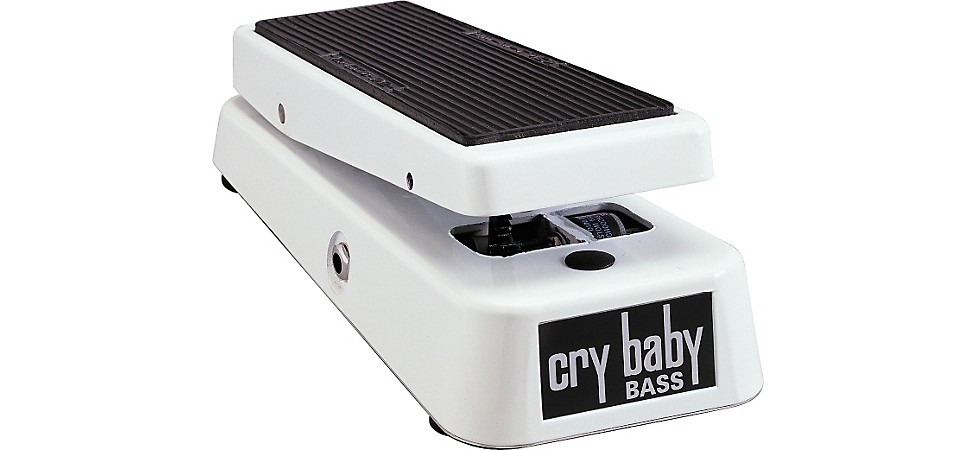
Shop Now: Dunlop Cry Baby 105Q Bass Wah
From early on, bass players experimented with wah pedals, but mostly switched to envelope filters because the wah pedals designed for guitarists were not kind to low frequencies when they were switched on. The Dunlop 105Q Bass Wah takes a unique approach to that problem achieving a "best of both worlds" solution.
The 105Q was designed from scratch expressly as a pedal for bassists, and it is almost a hybrid of a wah and an envelope filter. Dunlop engineers borrowed circuitry from their envelope filters but control the sweep of the filter with the pedal. They also mixed in the fundamental frequencies of the bass so low end is never lost, while the effect is primarily applied to the mid and high frequencies of the signal. A variable Q (filter resonance) control is located on the side of the pedal, enabling you to go from a standard Cry Baby wah sound to a more intense, focused sound at higher (which equals narrower) Q settings. There is also an adjustable boost of up to 20dB. For a touch of added coolness, Dunlop's neat switching system turns off the wah when you just lift your foot off the pedal.
MXR M82 Bass Envelope Filter
Why It’s Cool: This pedal delivers classic ’70s funk bass tones from your favorite records with the added flexibility of independent wet and dry blend controls.
Things to Consider:
- Retains more transient definition than a wah pedal
- Ability to keep your low end intact with the DRY blend knob
- Takes careful adjustment to dial in the right settings
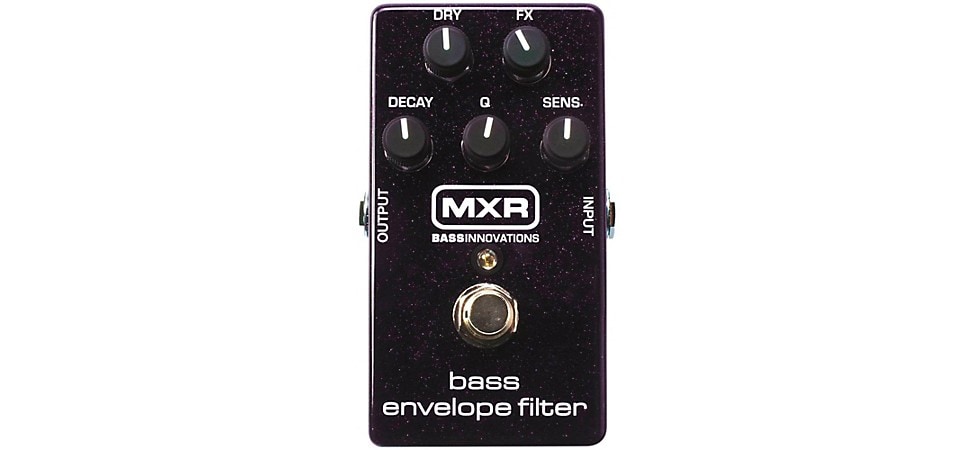
Shop Now: MXR M82 Bass Envelope Filter
One of the most iconic sounds in funk is the "wow-wow-wow" of an envelope filter. From OG Larry Graham with Sly and the Family Stone and Bootsy Collins' summoning of the Mothership with Parliament/Funkadelic to Flea and Marcus Miller, that particular type of sweeping filter is an integral part of funk bass history. The MXR M82 Bass Envelope Filter's all-analog design and simple controls make it an excellent choice if you are laying it down on the one.
One of the key features that puts the M82 on our list is the use of separate Dry and Effect level knobs as opposed to a single-blend knob. Separate levels allow for a greater range of filter effects from just barely noticeable to totally over the top. For the filter itself, there are three controls available. First, Decay, which sets the frequency where the envelope sweep will end. Next, Q sets the resonant frequency of the filter peak. Lastly, Sens (sensitivity) determines what level of attack will trigger the filter, making it possible, for example, for the envelope to only trigger on the loudest notes, such as a thumb pop, leaving regular fingerstyle plucks with medium dynamics untouched.
Best Modulation Bass Pedals
Swoosh, swirl and swim in the rich wash of modulation effects. We've got a pair of solid choices here to help liquify your sound.
|
Pedal |
Tonal Characteristics |
Power Draw |
EQ |
|
Thick and swirling |
9V, 40mA |
None |
|
|
Lush and organic |
9V, 12mA |
None |
BOSS BF-3 Flanger
Why It’s Cool: This adaptable, stereo effects pedal provides tantalizing, swirling tones for guitar or bass, and can add an extraterrestrial flavor to your pedalboard.
Things to Consider:
- Works with guitar and bass
- Tap tempo adjustable via pedal
- Momentary mode turns flanging on instantly
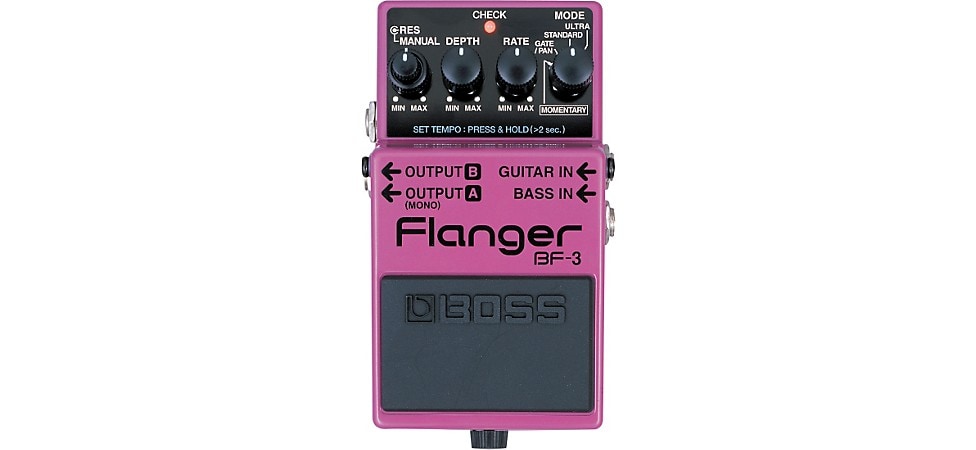
Shop Now: BOSS BF-3 Flanger Effects Pedal
The BOSS BF-3 Flanger adds features to the original BF-2 Flanger, creating a pedal that's great for bass or for guitar. While the BF-3 is a stereo/mono pedal, most bassists are likely to keep it in mono on their pedalboard. The unit has separate bass and guitar inputs, so if you play both, you can easily pop it from your bass pedalboard to your guitar one. BOSS offers four distinct modes for the pedal with amp control to tweak it to exactly where you need.
The control knobs start with a stacked pot that controls both the center frequency of the sweep (Manual) and the amount of feedback (Res), which controls the resonance of the effect. Next is the Depth knob, which controls the width of the flanger's sweep. This is followed by the Rate knob, which controls the speed. The final knob, going from left to right, controls the BF-3's mode of operation. There are four choices, the first two of which control the strength of the effect: Ultra provides an extra-strong flanging sound, whereas Standard is a normal flanger. The next choice, Gate/Pan creates massive volume differences in the flange sweep. In stereo mode, this acts as panning. In Mono, which is where you're most likely to be running it for bass, it creates a rhythmic gating effect, which can be a "chopper"-type of effect at extreme settings. Finally, Momentary activates the BF-3 in Standard flange mode only while the toe switch is depressed—great for adding a little touch of texture in the middle of a chorus.
Aguilar Chorusaurus
Why It’s Cool: This chorus pedal delivers fat, warm and organic sounds thanks to its bucket-brigade style circuitry.
Things to Consider:
- All-analog, bucket-brigade style chorus
- No HPF or crossover—the entire frequency range is affected
- RATIO control allows you to blend clean and effected signals

Shop Now: Aguilar Chorusaurus Bass Chorus Effects Pedal
Over the years, Aguilar has become synonymous with low end. Their amps and pickups are sought by bassists far and wide due to their thunderous, natural tone. Well, bass purists unite, because the Chorusaurus does not disappoint. Warm and versatile, this pedal is perfect for everything from fattening up your root signal, to full-blown underwater soundscapes. It has a deceptively simple set of controls that allow for a plethora of usable sounds fit for any genre or style. While the Chorusaurus can sound incredibly natural, it can be pushed into the beyond with more extreme settings, truly spanning the full range of musical possibilities any bassist could be searching for.
Best Multi-Effects Bass Pedals
Modern multi-effects units aren't just for guitarists. The ones we look at here are a solid basis for any bassist's effects arsenal.
|
Pedal |
Number Of Inputs |
Power Draw |
Onboard Expression Pedal |
|
1 INST, 1 AUX |
9V, 200mA |
Yes |
|
|
1 INST, 1 EXP/FS |
9V |
No |
|
|
1 INST, 1 FX RETURN |
9V, 195mA |
Yes |
|
|
1 (Mono) |
500mA |
No |
BOSS GT-1B Bass Multi-Effects
Why It’s Cool: If you’re looking for an all-in-one solution full of time-tested effects and functionality, BOSS (as always) has you covered.
Things to Consider:
- Built-in expression pedal
- Full suite of onboard effects
- Lightweight and rugged design is perfect for touring musicians
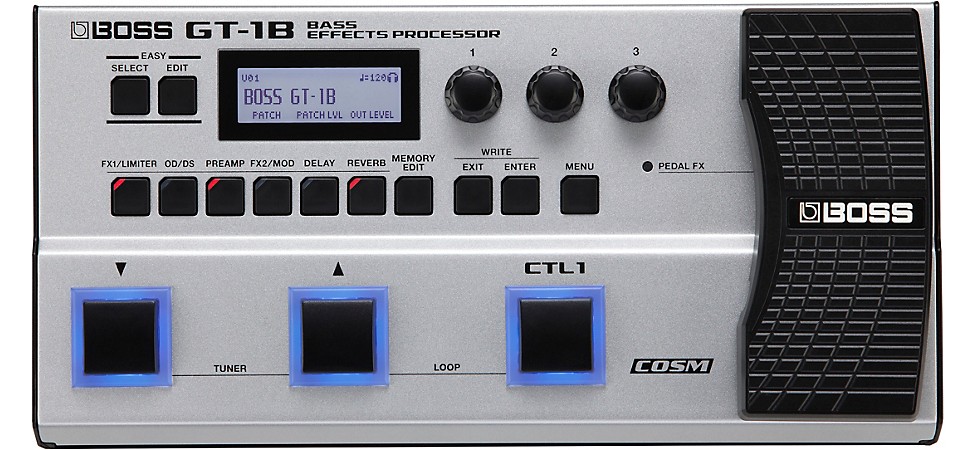
Shop Now: BOSS GT-1B Bass Multi-Effects Pedal
The BOSS GT-1B Bass multi-effects processor may be part of a pedalboard, or it could be your entire bass rig, especially if you do a lot of "silent stage" gigs. There are so many features here that we could probably write an entire article the length of the one you're reading now just on the GT-1B, so we're just going to touch on a few things.
First, the amp models use the well-respected Roland/BOSS COSM modeling engine. The available models include sounds based on vintage classics like the Ampeg B-15 and SVT, Fender Bassman and Acoustic 360, as well as modern amps from Gallien-Kruger, SWR, Markbass and more.
There are over 90 effects available, ranging from simple overdrives, wahs, compressors and EQs to bass synths, pitch shifting, harmonizers, ring modulators and more. We're pretty sure that every class of bass effect is covered in here somewhere and exploring the possibilities in this type of multi-effect is more than half the fun. For even more fun, there's a built-in looper.
I/O on the GT-1B is comprehensive with regular and AUX inputs, expression pedal input, stereo/mono output, headphone out, and a USB connection to use it as a class-compliant audio interface, edit the 99 supplied presets or create new ones in the 99 available user presets.
So, after using the built-in tuner, there is a lot to explore here. For sonically adventurous bassists, or for those who want to be, the BOSS GT-1B is an Aladdin's cave of musical magic, waiting to discover.
Line 6 POD Express Bass
Why It’s Cool: This compact pedal packs Line 6’s world-renowned effects and amp simulations into a pedalboard-friendly form factor fit for the most demanding of bassists.
Things to Consider:
- Built-in, award-winning HX modeling technology
- Versatile connectivity for studio use
- Portable design lets you take your tone with you

Shop Now: Line 6 POD Express Bass Effects Processor
A best-selling pedal we’ve all come to know over the years, the POD from Line 6 is now available in an on-the-go package made specifically for bassists. The POD Express Bass is the answer touring and recording players have been seeking for decades. What if you could have your compressor, distortion, delay and effects pedals, as well as an amp simulator with you wherever you went? Get ready to tap into your tone and be creative at a moment’s notice with this modern-day masterpiece. Essentially cramming your rig into one easy-to-use box, the POD Express Bass is able to tackle any task. With award-winning HX modeling powering seven amp models (and seven cabinets to match), there’s something for everyone in this musical multi-tool.
Seventeen effects, ranging from distortions to compressors and synths to modulations, give you the colors you need to paint a rich sonic landscape of unique, professional tones no matter what genre you play. Whenever and wherever inspiration strikes, you’ll be ready with the POD Express Bass.
BOSS ME-90B Bass Multi-Effects Processor
Why It’s Cool: This BOSS offering is a lightweight, seemingly do-it-all bass multi-effects processor with a boatload of features.
Things to Consider:
- Built-in USB-C, high-resolution audio interface
- Can be battery-powered
- 61 varied effect algorithms specifically for bass

Shop Now: BOSS ME-90B Bass Multi-Effects Pedal
BOSS managed to fit nearly everything a bassist could ever need into the ME-90B. An easy-to-transport floor processor worthy of the most discerning players, it includes a staggering array of options, from a built-in expression pedal and 93 types of effects to a phrase looper, modulator, compressor, pitch shifter, drive section and reverb. If you can’t find the effect you’re looking for in the ME-90B, it might not exist yet. Ten bass preamps are also included, along with a more than capable preset bank that is comprised of 36 factory and 36 user presets. Equally astonishing is the quality of all these sounds. Sporting 24-bit AD and 32-bit DA conversion, you’ll be playing (and even recording) in high definition utilizing the ME-90B’s internal 32-bit floating architecture. The unit also comes with Tone Studio, a PC-based app that lets you program and save presets easily.
For a price that’s comparable to purchasing a small handful (or sometimes just one) of individual stompboxes, the ME-90B delivers a whole spectrum of sonic possibilities and lays them at your feet.
Zoom MS-60B+ MultiStomp
Why It's Cool: Compact and powerful, this multi-effect stompbox packs dozens of high-end bass effects into one pedal-sized package.
Things to Consider:
- Over 100 effects, including amp models, modulation, delay and compression
- Single input; perfect for streamlined setups
- No onboard expression pedal

Shop Now: Zoom MS-60B+ MultiStomp Bass Effects Pedal
Zoom's MS-60B+ is purpose-built for bassists who want comprehensive effects without taking up pedalboard real estate. Offering an extensive collection of amp simulations, effects and precise tone-shaping tools, its intuitive, player-friendly interface allows quick tonal adjustments.
Best Synth Bass Pedals
There's only one pedal here, simply because it stands alone in what it does. But what it does is very special.
|
Pedal |
Tonal Characteristics |
Power Draw |
Total Voicings |
|
Analog-style synth, filter and distortion |
150mA |
8 |
|
|
Unique, synth-style weirdness |
9V, 40mA |
4 |
MXR Bass Synth
Why It's Cool: This pedal transforms your bass tone into analog synth sounds, ranging from funky envelope filters to thick synth-like distortion.
Things to Consider:
- Multiple synth voicings suitable for various styles
- Modest power draw for easy pedalboard integration
- Ideal for experimentation and unique bass textures

Shop Now: MXR Bass Synth Effects Pedal
The MXR Bass Synth pedal dishes out vibrant, authentic synth textures specially designed for bass guitar. From fat, analog-style synth leads to quirky filter sweeps, this pedal lets you transcend the conventional boundaries of instrumentation. Its straightforward control layout makes shaping otherworldly sounds easy, helping you stand out—from funk and electronic genres to indie rock and experimental soundscapes.
Electro-Harmonix Bass MicroSynth
Why It’s Cool: This extremely unique pedal gives you the ability to separate frequency ranges, process them through a heavy-handed filter section and mix them together to form tonal creations all your own.
Things to Consider:
- Four-voice mixer section consisting of sub octave, original, octave up and square wave
- All-analog design
- Delivers synth-like tones otherwise unachievable without a carefully designed signal chain
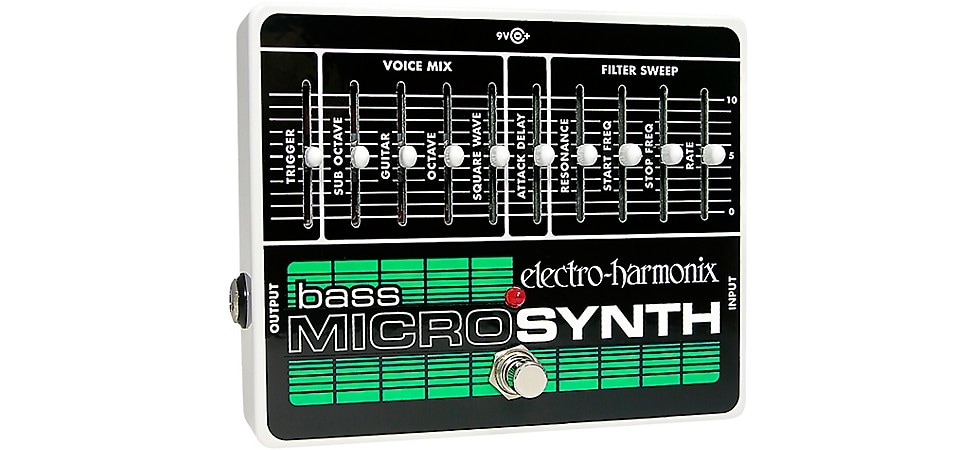
Shop Now: Electro-Harmonix Bass MicroSynth Effects Pedal
We were unsure just where to place the Electro-Harmonix Bass MicroSynth in this list. We wrestled with if it belonged with the filter, EQ and octave effects, because it can do all of that. Or, should it be with the multi-effects units, because it can do a whole lot of very, very cool stuff. At the last minute, we decided that it is so individual, it gets a category of its very own.
Designed to emulate the sounds of vintage analog synths of the '70s and '80s, the all-analog Bass MicroSynth uses your bass as a signal source to morph, mutate and mangle into glorious electro-madness.
The first step in the process is to take the one bass voice and process it to get four separate sounds—a sub-octave, straight bass sound, an octave above and a square wave at the original pitch. Mixing these together can create worthwhile sounds on its own, but the real magic happens when you process this through the filter section.
The filter section is a sweepable, three-pole resonant filter with sliders for Resonance, Start and Stop frequencies, and Rate of sweep. Before your signal hits the filter, there's also an Attack Delay slider that lets you go from instant attack to a slow volume swell. With a few adjustments, you can come up with a classic synth bass tone or a truly twisted warbling dinosaur war cry. No presets, but half the fun of this pedal is just playing and changing faders on the fly. Add a delay pedal after and you can really get in touch with your inner, weird child.
Wrapping It All Up
There's a lot to choose from here, and we hope we've pointed you in a good direction. We recommend that you relax, experiment and have as much fun as possible in assembling your collection of bass pedals. Once you've got three or more pedals, you'll probably want to check out our articles on building a pedalboard and choosing the right power supply for it.

Pictured: Dunlop Cry Baby 105Q Bass Wah
We're also going to remind you that you'll need some accessories to go along with your pedals. Essentials include power supplies, quality patch cables to hook everything up, a tuner—whether stompbox or headstock clip-on—and spare batteries. You'll also want a proper carrying bag for your pedals, especially if you're not building that full-blown pedalboard system yet. If you've got any questions, we'd also recommend having a chat with one of our knowledgeable associates, either at your local Guitar Center store or at our Call Center. They've been fielding questions about gear for years, and it's a pretty safe bet that most of them have stories about how stuff has gone wrong on gigs or in the studio, and how to solve those problems without panic.
Always remember, no matter how serious you are about it, playing is supposed to be fun. So, relax, enjoy, get out there.







